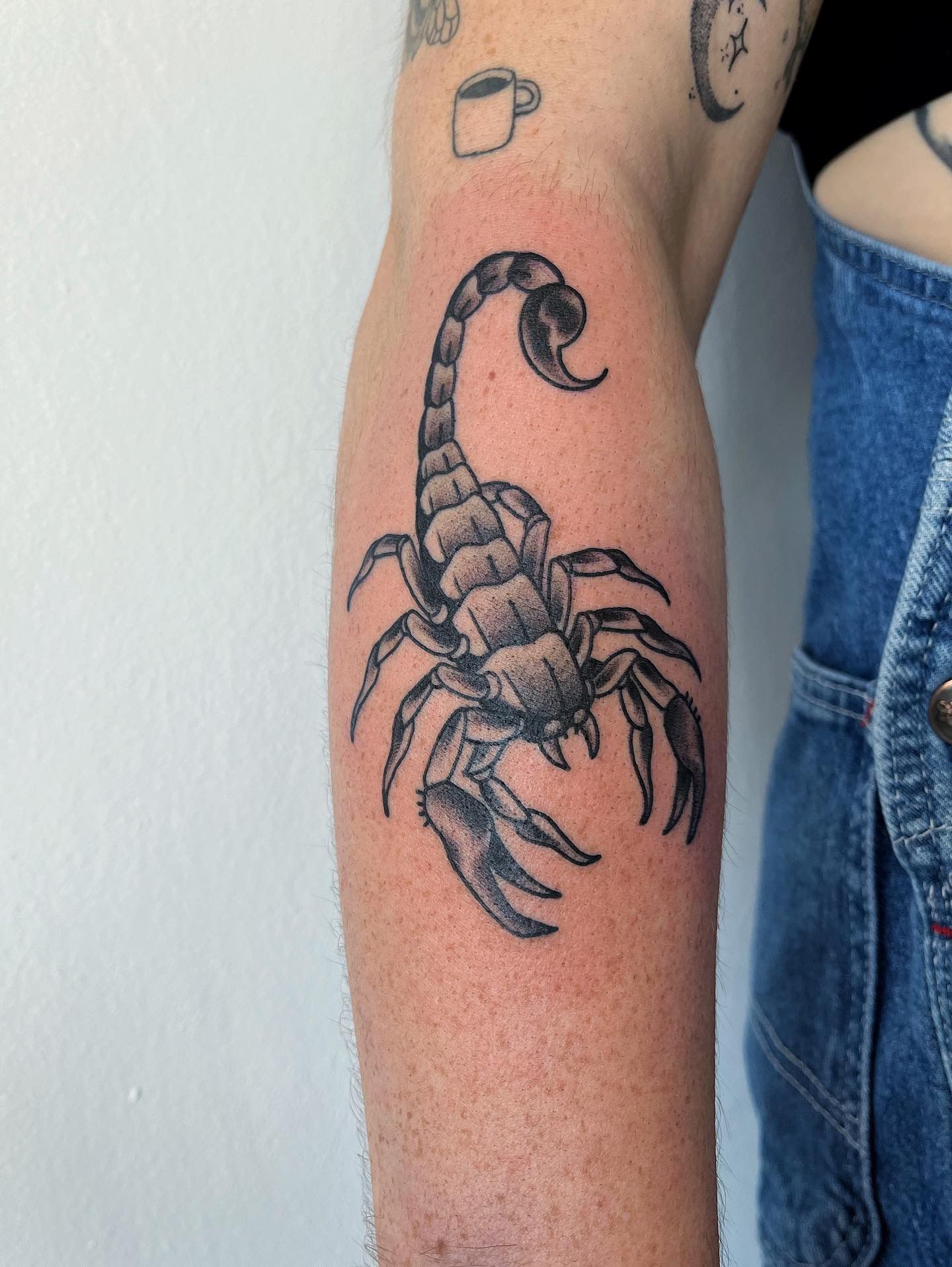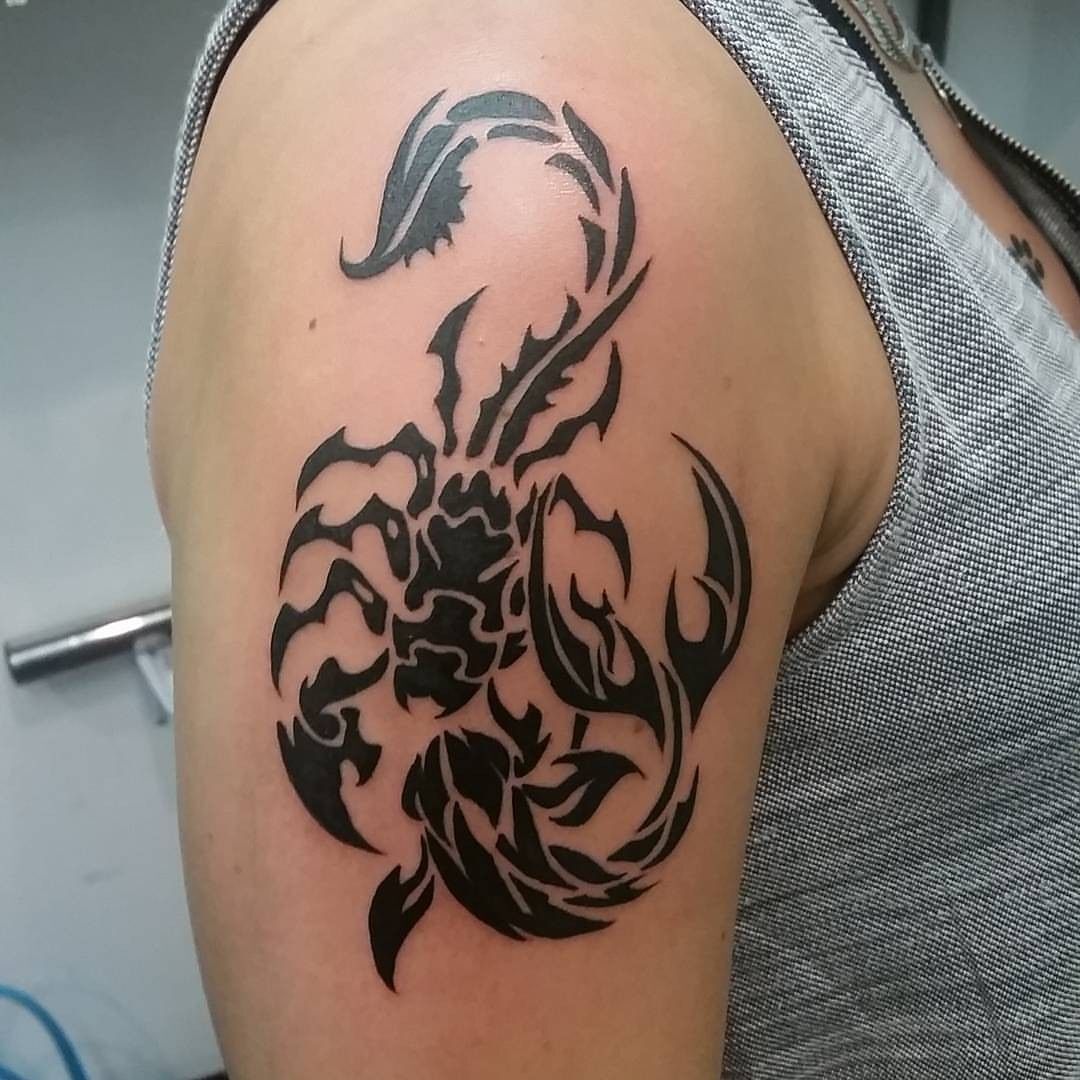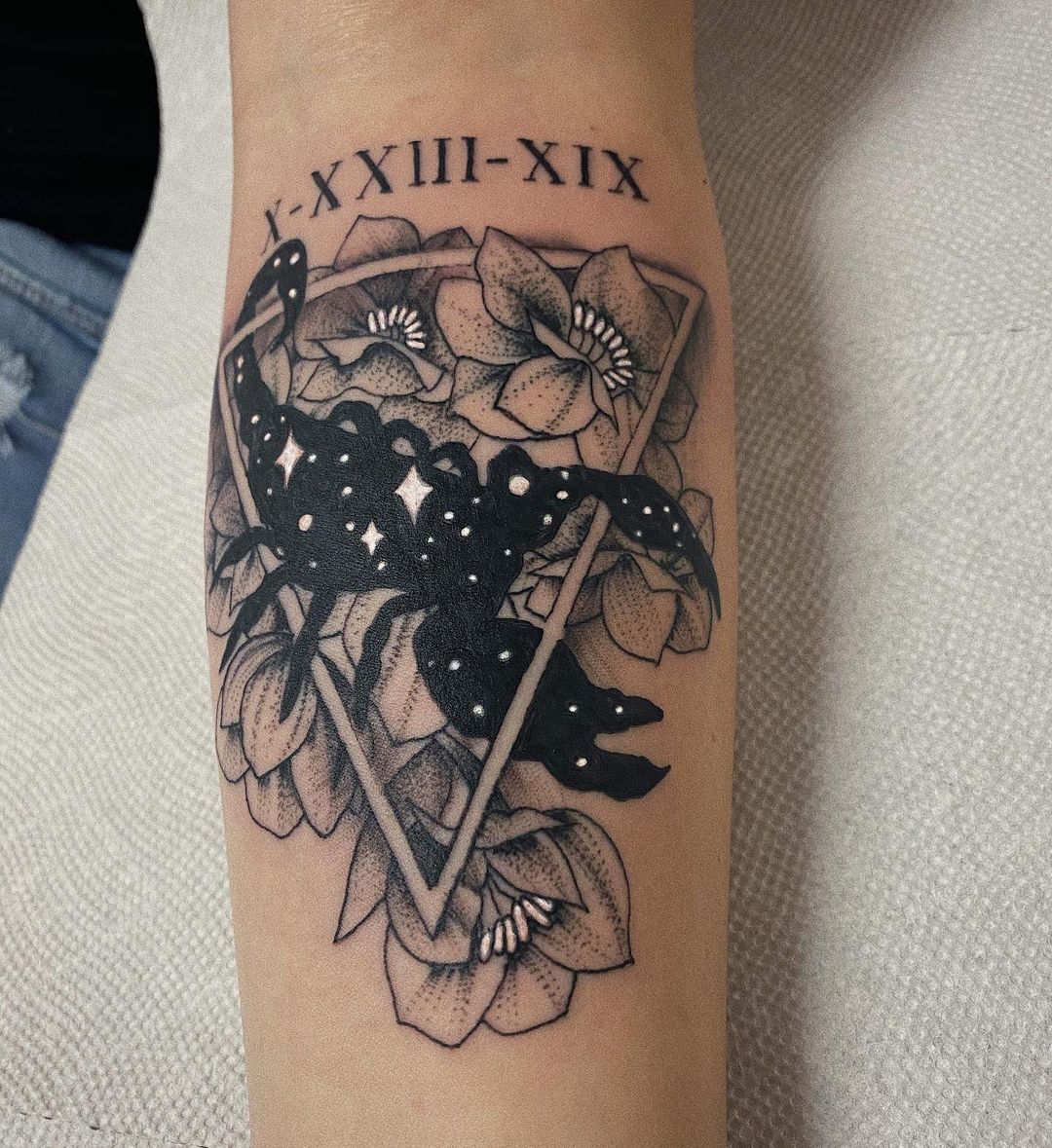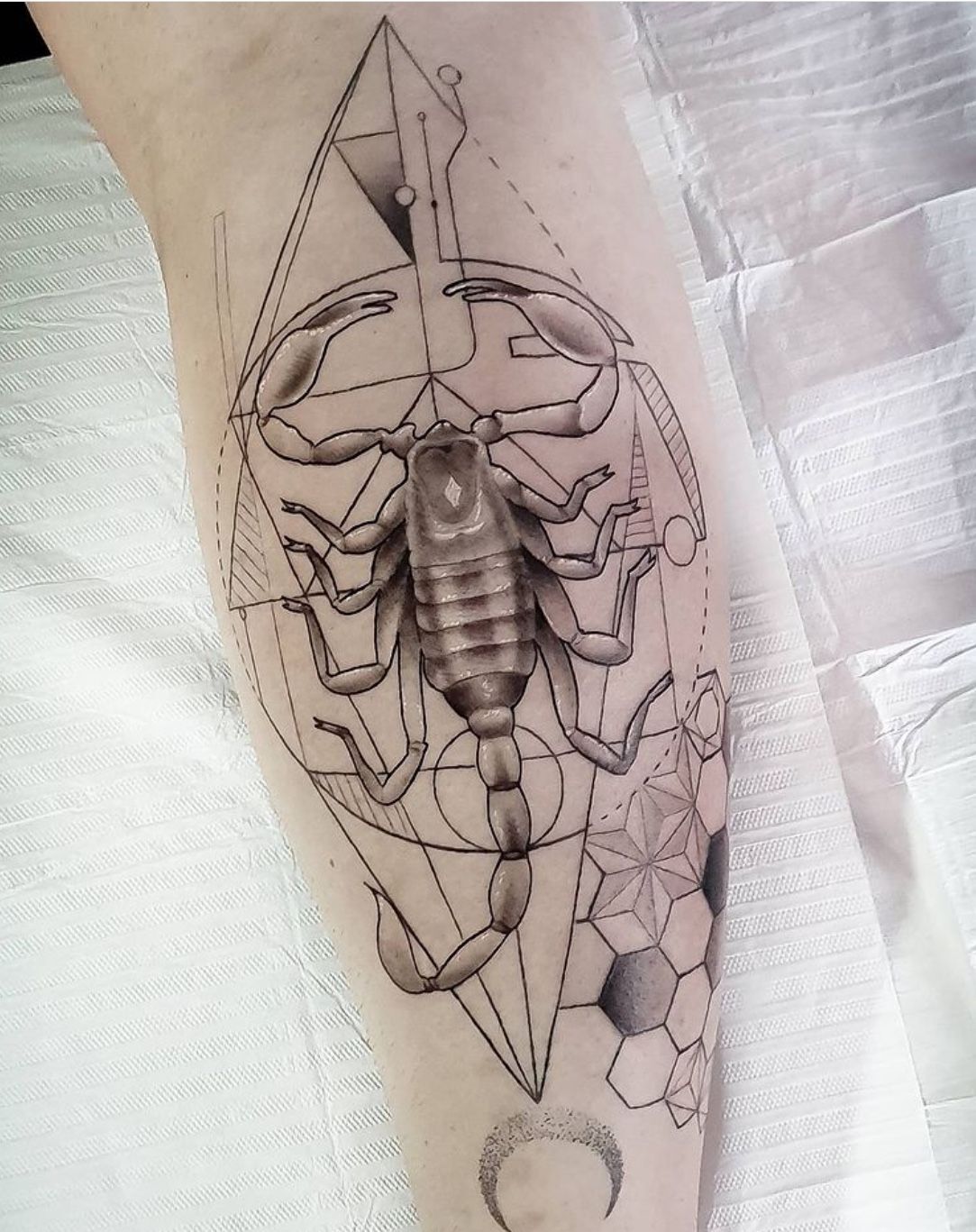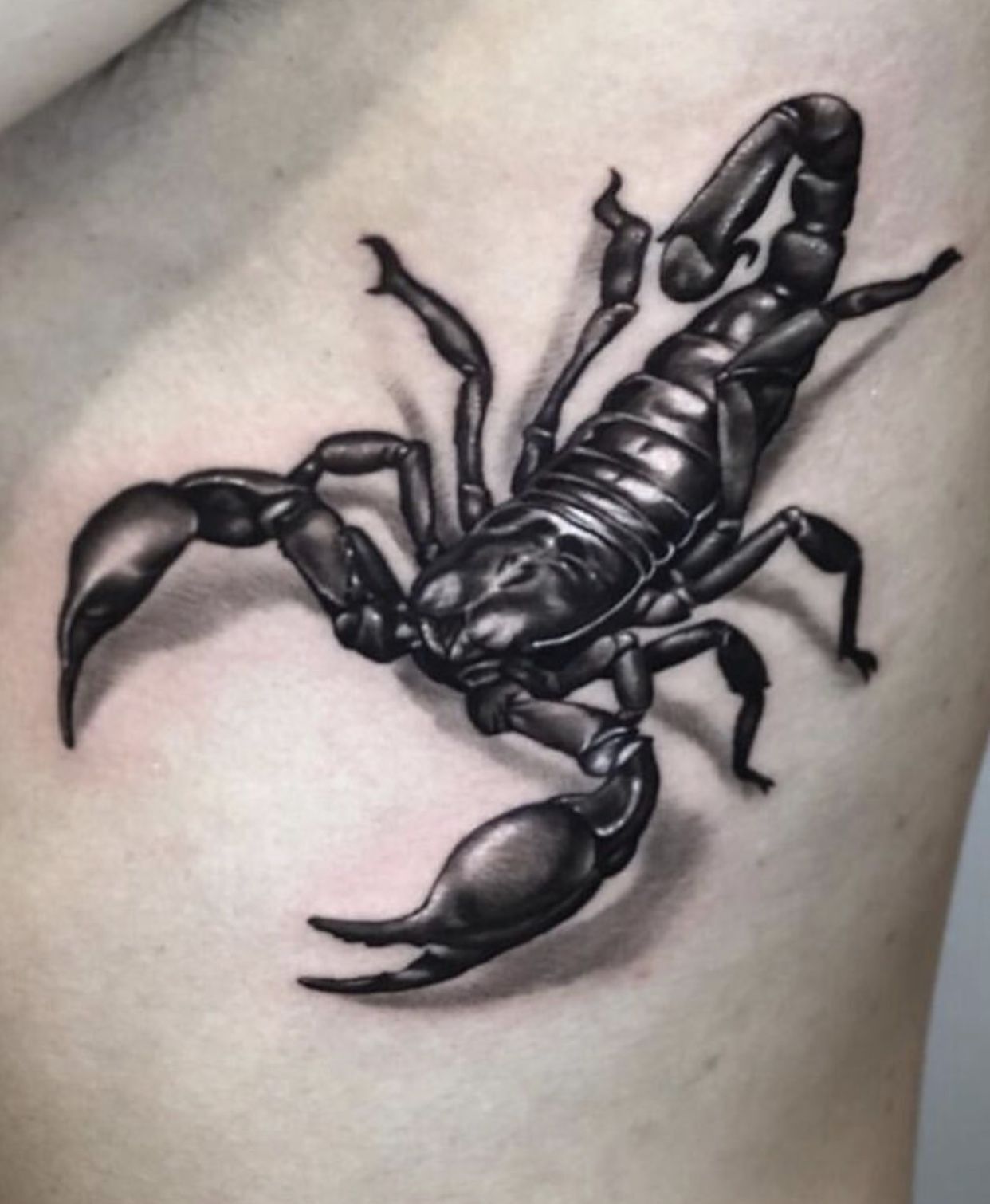Scorpion tattoos are among the most popular worldwide, known for their unique and eye-catching design. These tattoos have been popular for thousands of years, symbolizing various meanings and interpretations. Whether you're looking for a small, subtle design or a large, bold statement piece, a scorpion tattoo is an excellent choice for anyone looking for a powerful and meaningful tattoo.
Are you only interested in tattoo designs and want to skip the educational part?
No problem, we got you covered! Click HERE to get inspired.
What Is The Meaning Of Scorpion Tattoos?
Scorpion tattoos are deeply symbolic and their meanings are associated with the attributes of the scorpion itself. They are often interpreted as symbols of strength and power, reflecting the scorpion's formidable presence and deadly sting.
Additionally, they represent survival and protection, as scorpions are known for their ability to live in harsh environments and their potent defensive capabilities. In the realm of personal symbolism, a scorpion tattoo can denote a fierce, resilient spirit and the power to overcome challenges. This is especially true in astrology where the scorpion, as the symbol for the Scorpio zodiac sign, is associated with intensity, passion, and mystery.
However, meanings can vary based on cultural background and personal perspective, imbuing the scorpion tattoo with a nuanced and multifaceted symbolism.
What Do Scorpions Symbolize in Different cultures?
In various cultures worldwide, scorpions symbolize an array of complex themes. Scorpions are often associated with passion, protection, death, and defiance due to their potent venom and hardy nature. In ancient Egypt, the scorpion was revered as a symbol of protection. Serket, the Scorpion Goddess, was invoked for protection against venomous stings and bites. On the contrary, in Biblical references, scorpions symbolize danger, pain, and hardship, often linked to the trials of life and the need for resilience.
In Native American culture, particularly among Hopi and Pueblo tribes, scorpions are respected for their ability to balance the good and evil, signifying transformation and the cycle of death and rebirth.
Furthermore, in astrology, Scorpio, represented by a scorpion, is associated with intensity, mystery, and deep emotions, reinforcing the scorpion's symbol as a sign of passion and power.
The symbolism of scorpions in Chinese culture is somewhat dual. On one hand, they are considered a sign of evil, but on the other, they also represent tenacity and the ability to survive in harsh conditions.
Finally, in some African cultures, scorpions signify danger and painful experiences but also act as a warning signal to tread cautiously in life.
Thus, the symbolism of scorpions in different cultures spans a broad range from protection and transformation to danger and defiance, demonstrating the creature's multifaceted nature.
best scorpion tattoo ideas and their meanings
Scorpion tattoos are rich in symbolism and have been a popular choice among tattoo enthusiasts for their unique aesthetic and deep meanings. From strength and survival to passion and mystery, these designs capture various facets of human experience. Here are five top-rated scorpion tattoo ideas along with their associated meanings:
Traditional Scorpion Tattoo
This classic black and gray design often symbolizes power and survival. With the scorpion poised for action, it's a reminder of one's inner strength and tenacity.
Tribal Scorpion Tattoo
Drawing on the rich heritage of tribal art, these tattoos can represent protection, warding off evil spirits. The intricate patterns signify the complexity of life and the warrior spirit.
Scorpio Zodiac Tattoo
Ideal for those born under the Scorpio zodiac sign, these designs encapsulate the traits of intensity, passion, and emotional depth associated with Scorpios.
Geometric Scorpion Tattoo
With its modern and sleek look, a geometric scorpion represents balance and precision, resonating with people who appreciate the harmony of nature and the order within chaos.
3D Scorpion Tattoo
These lifelike designs can symbolize transformation, reflecting the scorpion's ability to survive and adapt in different environments. It can be a visual testament to the wearer's resilience and adaptability.
Who should get a scorpion tattoo?
A scorpion tattoo is an excellent choice for individuals who resonate with the various symbolic meanings attributed to the scorpion. These tattoos are often favored by those who see themselves as powerful, resilient, and capable of overcoming challenges, mirroring the scorpion's formidable nature and survival capabilities.
It can also appeal to people born under the Scorpio zodiac sign, given the connection between the creature and the astrological symbol. Moreover, fans of tribal or ancient art may be drawn to scorpion tattoos due to their cultural significance in different ancient civilizations.
Ultimately, a scorpion tattoo is fitting for anyone who identifies with its multifaceted symbolism, ranging from passion and intensity to mystery and transformation.
General Breakdown Of Tattoo Pain Levels On Different Body Parts
Here is a breakdown of the different tattoo pain levels:
- Low: This level of pain is generally described as a mild discomfort or tickling sensation. It is similar to the sensation of getting a light scratch or scrape.
- Moderate: This level of pain is generally described as a moderate discomfort or aching sensation. It is similar to the sensation of getting a deep scratch or scrape or being pinched.
- High: This level of pain is generally described as a strong discomfort or throbbing sensation. It is similar to the sensation of getting a burn or being stung by a bee.
It's important to note that pain tolerance is highly individual and can vary greatly from person to person. Some people may find certain body parts more or less painful than others, and the same body part can be more or less painful for different people. Additionally, the level of pain can be affected by factors such as the size and location of the tattoo, the skill of the tattoo artist, and the individual's own pain threshold.
Tattoo placement pain level chart
Body Part | Pain Level | Explanation |
Forehead | Low | The forehead has few nerve endings, so it is not a particularly painful area. |
Eyebrows | Low | The eyebrows have few nerve endings, so the pain level is relatively low. |
Ear | Low | The ear is a relatively thin and fleshy area, so the pain level is low. |
Nostril | Low | The nostril is a small area with thin skin, so the pain level is low. |
Lip | Low to Moderate | The lip has more nerve endings than some other areas, so it may be slightly more painful. |
Cheek | Low to Moderate | The cheek has a moderate amount of nerve endings, so it may be slightly more painful. |
Moderate | The neck has a moderate amount of nerve endings, so it may be slightly more painful. | |
Moderate to High | The chest has a high concentration of nerve endings, so it can be quite painful. | |
Abdomen | High | The abdomen has a high concentration of nerve endings, so it can be quite painful. |
Back | High | The back has a high concentration of nerve endings, so it can be quite painful. |
Shoulders | High | The shoulders have a high concentration of nerve endings, so they can be quite painful. |
Upper Arms | Moderate to High | The upper arms have a moderate to high concentration of nerve endings, so they can be somewhat painful. |
Elbows | High | The elbows have a high concentration of nerve endings, so they can be quite painful. |
Forearms | Moderate | The forearms have a moderate concentration of nerve endings, so they are not as painful as some other areas. |
Hands | High | The hands have a high concentration of nerve endings, so they can be quite painful. |
Lower Arms | Low to Moderate | The lower arms have a lower concentration of nerve endings, so they are not as painful as some other areas. |
Wrists | Low | The wrists have a low concentration of nerve endings, so they are not very painful. |
Lower Back | High | The lower back has a high concentration of nerve endings, so it can be quite painful. |
Buttocks | High | The buttocks have a high concentration of nerve endings, so they can be quite painful. |
Thighs | High | The thighs have a high concentration of nerve endings, so they can be quite painful. |
Knees | High | The knees have a high concentration of nerve endings, so they can be quite painful. |
Calves | Low to Moderate | The calves have a low to moderate concentration of nerve endings, so they are not as painful as some other areas. |
Ankles | Low | The ankles have a low concentration of nerve endings, so they are not very painful. |
Tattoo aftercare tips
Before getting a tattoo:
Choose a reputable tattoo artist and parlor. Research the artist's portfolio and read reviews from previous clients.
Consult with the artist about the design and placement of the tattoo.
Make sure you are in good health. If you have any medical conditions or are taking any medications that may affect your ability to heal, be sure to let your tattoo artist know.
Consider using a numbing cream to reduce pain during the tattooing process. These creams contain a numbing agent (such as lidocaine) that can be applied to the skin before the tattoo is done. It's important to follow the instructions on the numbing cream and to only use it as directed.
Avoid alcohol, caffeine, and other substances that can thin your blood for at least 24 hours before getting a tattoo.
Eat a healthy meal before your tattoo session to ensure that your blood sugar is stable.
Wear loose, comfortable clothing that allows easy access to the area being tattooed.
After getting a tattoo:
Follow the aftercare instructions provided by your tattoo artist. These may include:
Keeping the tattoo clean and covered with a bandage for the first few hours after getting tattooed.
Washing the tattoo with lukewarm water and a mild soap (such as unscented, antimicrobial soap) and patting it dry with a clean towel.
Applying a thin layer of tattoo ointment or lotion (such as A&D or Aquaphor) to the tattoo and covering it with a clean bandage or wrap.
Repeating this process for the first few days, or until the tattoo has fully scabbed over.
Avoid soaking the tattoo in water for the first week, such as in a bath or pool.
Avoid picking or scratching at the scabs, as this can cause the tattoo to fade or become infected.
Avoid exposure to direct sunlight or tanning beds for at least 2-4 weeks.
If you experience any redness, swelling, or unusual discharge, contact your tattoo artist or a healthcare professional.
Overall, it's important to keep your tattoo clean and moisturized during the healing process to ensure that it heals properly and looks its best. Using a numbing cream can help reduce pain during the tattooing process, but it's important to use it as directed and to follow all aftercare instructions to ensure that your tattoo heals properly.
People Also Ask:
What does a scorpion tattoo symbolize?
A scorpion tattoo typically symbolizes strength, power, and resilience. It reflects the scorpion's formidable nature and its ability to survive in harsh environments. The exact symbolism can vary based on cultural and personal interpretations.
Who should get a scorpion tattoo?
Scorpion tattoos are often chosen by individuals who resonate with its symbolic meanings such as resilience, power, and survival. It is also popular among those born under the Scorpio zodiac sign, and individuals who appreciate tribal or ancient art.
Are scorpion tattoos associated with the Scorpio zodiac sign?
Yes, the scorpion is the symbol for the Scorpio zodiac sign. Therefore, many Scorpios or those who identify with the traits of this sign—like intensity, passion, and mystery—might choose to get a scorpion tattoo.
What cultures hold significant meanings for scorpion tattoos?
Several cultures have meaningful associations with scorpion tattoos. For instance, in ancient Egypt, scorpions were a symbol of protection, while in some Native American tribes, they symbolized balance between good and evil.
Is a scorpion tattoo considered to be a protective symbol?
In many cultures, a scorpion is seen as a protective symbol due to its defensive capabilities. Therefore, a scorpion tattoo can be interpreted as a symbol of protection.
Can the placement of the scorpion tattoo change its meaning?
While the primary symbolism of a scorpion tattoo is usually consistent, the tattoo's placement can sometimes add personal significance or highlight certain aspects of its meaning.
Is it common for a scorpion tattoo to be combined with other elements?
Yes, it's quite common. A scorpion tattoo can be combined with various elements, such as flowers, celestial bodies, or other symbols to create a more personalized and unique design that enhances or alters its symbolic meaning.
What is a 3D scorpion tattoo?
A 3D scorpion tattoo is a lifelike design that appears three-dimensional. These tattoos are often associated with transformation and adaptability, reflecting the scorpion's ability to survive in different environments.
What is a geometric scorpion tattoo?
A geometric scorpion tattoo incorporates geometric shapes and lines to create a modern and stylized image of a scorpion. It often symbolizes balance, precision, and the harmony found within chaos.
Can the color of the scorpion tattoo change its symbolism?
Yes, the color can influence the symbolism of the tattoo. For instance, a red scorpion might signify passion or danger, while a black scorpion could symbolize mystery, death, or resilience. However, the interpretation can vary widely depending on cultural and personal perspectives.
Watch A video of a scorpion tattoo done by a pro
200+ scorpion tattoo Ideas to get inspired from
Final thoughts
In conclusion, a scorpion tattoo is an excellent choice for a meaningful and powerful tattoo. With various designs and interpretations, there is a scorpion tattoo out there for everyone. Just remember to choose a reputable artist and always take the necessary precautions to ensure a safe and successful tattoo experience.

